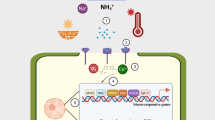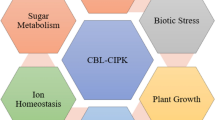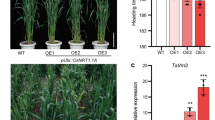Abstract
OsLEA4, a late embryogenesis abundant (LEA) protein gene from rice (Oryza sativa L.), contains a 312-bp open reading frame encoding a putative polypeptide of 103 amino acids with a calculated molecular mass of 11.19 kDa and a theoretical pI of 10.04. OsLEA4 polypeptide is rich in Ala (22%), Lys (15%), Glu (9%), His (8%), Thr (8%), and Arg (7%) and lacking in Trp, Cys, Asn, and Phe residues. OsLEA4 protein contains a Pfam:LEA_1 domain architecture at positions 1–73 with three α-helical domains and without β-sheet domain. In silico predictions showed that OsLEA4 protein was strongly hydrophilic with the grand average of hydropathy value of −0.816 and instability index of 27.31. The hydrophilic regions were found in the conserved motif of OsLEA4. OsLEA4 gene was introduced into Escherichia coli, and a fusion protein (∼29.4 kDa) was expressed after isopropylthio-β-d-galactoside inducting by sodium dodecyl sulfate–polyacrylamide gel electrophoresis analysis. OsLEA4 protein enhanced the tolerance of E. coli recombinant to high salinity, heat, freezing, and UV radiation, which suggested that OsLEA4 protein may play a protective role under stressed conditions. This is the first successful use of E. coli as a prokaryotic system for LEA production from rice.







Similar content being viewed by others
Abbreviations
- GRAVY:
-
Grand average of hydropathy
- IPTG:
-
Isopropylthio-β-d-galactoside
- LEA:
-
Late embryogenesis abundant
- LB:
-
Luria–Bertani
- ORF:
-
Open reading frame
- ROS:
-
Reactive oxygen species
- SDS-PAGE:
-
Sodium dodecyl sulfate–polyacrylamide gel electrophoresis
- UV:
-
Ultraviolet
References
Dure, L. III, Greenway, S. C., & Galau, G. A. (1981). Developmental biochemistry of cottonseed embryogenesis and germination: changing messenger ribonucleic acid populations as shown by in vitro and in vivo protein synthesis. Biochemistry, 20, 4162–4168.
Roberts, J. K., DeSimone, N. A., Lingle, W. L., & Dure, L. III. (1993). Cellular concentrations and uniformity of cell-type accumulation of two LEA proteins in cotton embryos. The Plant Cell, 5, 769–780.
Tunnacliffe, A., & Wise, M. J. (2007). The continuing conundrum of LEA proteins. Naturwissenschaften, 94, 791–812.
Battaglia, M., Olvera-Carrillo, Y., Garciarrubio, A., Campos, F., & Covarrubias, A. A. (2008). The enigmatic LEA proteins and other hydrophilins. Plant Physiology, 148, 6–24.
Shih, M. D., Hoekstra, F. A., & Hsing, Y. I. C. (2008). Late embryogenesis abundant proteins. Advances in Botanical Research, 48, 211–255.
Dure, L. III. (1993). Structural motifs in LEA proteins. Curr. Top Plant Physiol., 10, 91–103.
Campos, F., Zamudio, F., & Covarrubias, A. A. (2006). Two different late embryogenesis abundant proteins from Arabidopsis thaliana contain specific domains that inhibit Escherichia coli growth. Biochemical and Biophysical Research Communications, 342, 406–413.
Lisse, T., Bartels, D., Kalbitzer, H. R., & Jaenicke, T. (1996). The recombinant dehydrin-like desiccation stress protein from the resurrection plant Craterostigma plantagineum displays no defined three-dimensional structure in its native state. Biological Chemistry, 377, 555–561.
Soulages, J. L., Kim, K., Walters, C., & Cushman, J. C. (2002). Temperature induced extended helix/random coil transitions in group 1 late embryogenesis-abundant protein from soybean. Plant Physiology, 128, 822–832.
Tompa, P. (2002). Intrinsically unstructured proteins. Trends in Biochemical Sciences, 27, 527–533.
Bies-Ethève, N., Gaubier-Comella, P., Debures, A., Lasserre, E., Jobet, E., Raynal, M., et al. (2008). Inventory, evolution and expression profiling diversity of the LEA (late embryogenesis abundant) protein gene family in Arabidopsis thaliana. Plant Molecular Biology, 67, 107–124.
Dalal, M., Tayal, D., Chinnusamy, V., & Bansal, K. C. (2009). Abiotic stress and ABA-inducible Group 4 LEA from Brassica napus plays a key role in salt and drought tolerance. Journal of Biotechnology, 139, 137–145.
George, S., Usha, B., & Parida, A. (2009). Isolation and characterization of an atypical LEA protein coding cDNA and its promoter from drought-tolerant plant Prosopis juliflora. Applied Biochemistry and Biotechnology, 157, 244–253.
Liu, Y., Zheng, Y., Zhang, Y., Wang, W., & Li, R. (2010). Soybean PM2 protein (LEA3) confers the tolerance of Escherichia coli and stabilization of enzyme activity under diverse stresses. Current Microbiology, 60, 373–378.
Olvera-Carrillo, Y., Campos, F., Reyes, J. L., Garciarrubio, A., & Covarrubias, A. A. (2010). Functional analysis of the group 4 late embryogenesis abundant proteins reveals their relevance in the adaptive response during water deficit in Arabidopsis thaliana. Plant Physiology, 154, 373–390.
Wang, X. S., Zhu, H. B., Jin, G. L., Liu, H. L., Wu, W. R., & Zhu, J. (2007). Genome-scale identification and analysis of LEA genes in rice (Oryza sativa L.). Plant Science, 172, 414–420.
Hundertmark, M., & Hincha, D. (2008). LEA (late embryogenesis abundant) proteins and their encoding genes in Arabidopsis thaliana. BMC Genomics, 9, 118.
Kyte, J., & Dolittle, R. F. (1982). A simple method for displaying the hydropathic character of a protein. Journal of Molecular Biology, 157, 105–132.
Ali-Benali, M. A., Alary, R., Joudrier, P., & Gautier, M. F. (2005). Comparative expression of five Lea Genes during wheat seed development and in response to abiotic stresses by real-time quantitative RT-PCR. Biochimica et Biophysica Acta, 1730, 56–65.
Kabsch, W., & Sander, C. (1983). Dictionary of protein secondary structure: pattern recognition of hydrogen-bonded and geometrical features. Biopolymers, 22, 2577–2637.
Jones, D. T. (1999). Protein secondary structure prediction based on position-specific scoring matrices. Journal of Molecular Biology, 292, 195–202.
Linding, R., Jensen, L. J., Diella, F., Bork, P., Gibson, T. J., & Russell, R. B. (2003). Protein disorder prediction: implications for structural proteomics. Structure, 11, 1453–1459.
Saitu, N., & Nei, M. (1987). The neighbor-joining method: a new method for reconstructing phylogenetic tress. Molecular and Biological Evolution, 4, 406–425.
Wise, M. J. (2003). LEAping to conclusions: a computational reanalysis of late embryogenesis abundant proteins and their possible roles. BMC Bioinform., 4, 52.
Tolleter, D., Jaquinod, M., Mangavel, C., Passirani, C., Saulnier, P., Manon, S., et al. (2007). Structure and function of a mitochondrial late embryogenesis abundant protein are revealed by desiccation. The Plant Cell, 19, 1580–1589.
Nakayama, K., Okawa, K., Kakizaki, T., Honma, T., Itoh, H., & Inaba, T. (2007). Arabidopsis Cor15am is a chloroplast stromal protein that has cryoprotective activity and forms oligomers. Plant Physiology, 144, 513–523.
Shih, M. D., Hsieh, T. Y., Lin, T. P., Hsing, Y. I., & Hoekstra, F. A. (2010). Characterization of two soybean (Glycine max L.) LEA IV proteins by circular dichroism and Fourier transform infrared spectrometry. Plant & Cell Physiology, 51, 395–407.
Apel, K., & Hirt, H. (2004). Reactive oxygen species: metabolism, oxidative stress, and signal transduction. Annual Review of Plant Biology, 55, 373–399.
Mowla, S. B., Cuypers, A., Driscoll, S. P., Kiddle, G., Thomson, J., Foyer, C. H., et al. (2006). Yeast complementation reveals a role for an Arabidopsis thaliana late embryogenesis abundant (LEA)-like protein in oxidative stress tolerance. The Plant Journal, 48, 743–756.
Wang, B. F., Wang, Y. C., Zhang, D. W., Li, H. Y., & Yang, C. P. (2008). Verification of the resistance of a LEA gene from Tamarix expression in Saccharomyces cerevisiae to abiotic stresses. Journal of Forestry Research, 19, 58–62.
Acknowledgments
This study was supported by the China National Transgenic Major Program (2009ZX08009-109B), the University Innovation Team Construction Project of Chongqing Education Committee (201040), and The Natural Science Foundation Project of Chongqing Education Committee (KJ111108).
Author information
Authors and Affiliations
Corresponding author
Electronic Supplementary Material
Below is the link to the electronic supplementary material.
Table S1
The GenBank accession numbers of proteins used for analysis (DOC 51 kb)
Rights and permissions
About this article
Cite this article
Hu, T., Zeng, H., He, S. et al. Molecular Analysis of OsLEA4 and Its Contributions to Improve E. coli Viability. Appl Biochem Biotechnol 166, 222–233 (2012). https://doi.org/10.1007/s12010-011-9418-5
Received:
Accepted:
Published:
Issue Date:
DOI: https://doi.org/10.1007/s12010-011-9418-5




